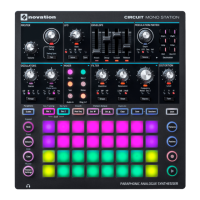Rear View – connectors
1236 47 58910
1
LINE OUT – the main (mono) audio output on a ¼” TRS jack socket. Max. output level is
+10.5 dBu. The output is pseudo-balanced (ground compensated) and may be connected to
equipment with either balanced or unbalanced inputs.
2
AUDIO IN – a line level input allowing an external audio signal to be added to Circuit Mono
Station’s output (via Mixer level control
27
).
3
MIDI IN, OUT and THRU – MIDI connectors on three 3.5 mm TRS jack sockets. Use the
break-out cables supplied to convert these to the industry-standard 5-pin DIN sockets.
4
CLOCK OUT – a 3.5 mm TRS jack socket supplying a clock signal of 5 V amplitude, at a
rate proportional to the tempo clock: the actual ratio can be set in Settings View. The default
rate is one pulse per quarter note.
5
CLOCK IN – a 3.5 mm TRS jack socket for an external clock source. Each pulse applied
advances the sequence by a quarter note. Range: -0.5 V to +5.5 V. Sensitivity: Below 1 V low /
Above 2.3 V high
6
NOTE OUT – two 3.5 mm TRS jack sockets carrying Control Voltage (CV) and GATE
signals derived from Osc 1’s sequence for driving compatible external equipment. The CV
output is scaled at 1 V per octave and the GATE output 5 V amplitude.
7
AUX CV – a secondary CV output (+5 V to -5 V on a 3.5 mm TRS jack socket) whose
source may be assigned in the Modulation Matrix.
8
– Type B USB 2.0 port. A Type B-to-Type A cable is supplied with the unit. The port
is MIDI class compliant; connect to computers and other devices supporting MIDI via USB to
transmit and receive MIDI data. Also used for rmware updates. Note – Circuit Mono Station’s
USB port does not carry either DC power or audio.
9
– power input socket. Circuit Mono Station requires 12 V DC at 1 A. Connect the AC
adaptor supplied to this coaxial socket.
10
POWER – “soft” on/off switch; to prevent inadvertent power up/down, a press of approx. half
a second is needed to turn the unit on or off.

